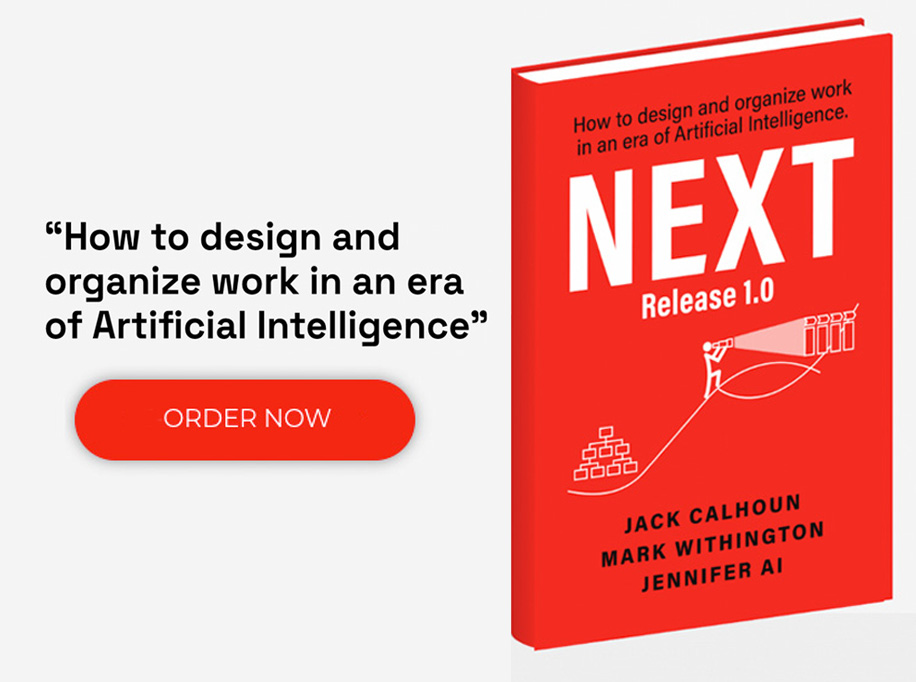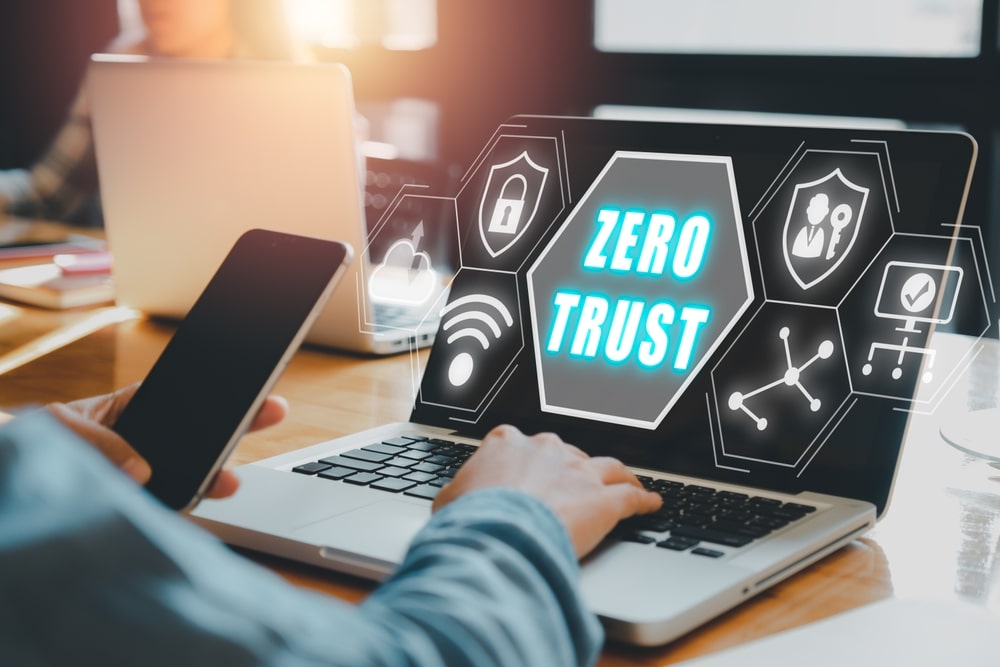The dissolving perimeter. The sophisticated attacker. The remote workforce. All of these factors converge to create unprecedented challenges for cybersecurity teams on a daily basis. Against the never-ending forces of digital disruption, Zero Trust security stands out as more than just another trend. It is a strategic necessity. By assuming that no user, device, or network can be inherently trusted, Zero Trust flips the old “trust but verify” adage on its head. Join us for a critical unpacking of how this mindset shift is critical for defending against ongoing threats and fueling digital transformation initiatives.
Related Article: What is Digital Disruption? A Guide for Business Leaders
Zero Trust Security, Explained
Zero Trust is a security framework that assumes threats can come from both inside and outside the network, and therefore no user, device, or application can be automatically trusted.
Zero Trust aims to create security and resilience by eliminating the traditional perimeter-based security model and instead focusing on protecting individual resources and data. This approach is particularly important in the context of remote work, cloud computing, and increasing cyber threats.
The Growing Importance of Zero Trust in Modern Cybersecurity
Cybercrime costs in the United States reached an alarming $452.3 billion in 2024, a significant increase from lower levels in 2017. Even more concerning, projections indicate this figure could balloon to a staggering $1.82 trillion by 2028 if current trends continue. As cybercriminals become more sophisticated and the attack surface expands with remote work and cloud adoption, organizations face incredible financial and reputational risk from breaches and attacks.
In this high-stakes environment, Zero Trust security is an essential paradigm for protection. By assuming no user, device, or network traffic is trustworthy, Zero Trust forces organizations to robustly authenticate and authorize all access. Principles like least-privileged access, micro-segmentation, and continuous monitoring help contain the blast radius of any breach that does occur.
With comprehensive visibility and granular control, Zero Trust makes it exponentially harder for cybercriminals to gain a foothold and limits the damage they can inflict. Given that a single attack can cost millions and jeopardize reputations, Zero Trust is imperative for businesses.
Well beyond bolstering defenses, Zero Trust also drives digital transformation initiatives because legacy perimeter-based security models often constrain innovation and collaboration. Zero Trust changes the game with seamless, secure access to resources from anywhere by decoupling security from the network and basing it on identity and behavior. This allows organizations to embrace cloud, mobile, and remote work while still maintaining strong safeguards. With Zero Trust, security becomes a business driver rather than a business blocker. It provides the confidence to pursue digitally enabled growth and new ways of working.
The Core Principles of Zero Trust Security
Zero Trust security consists of the following three principles:
Principle 1: Verify Explicitly
Always authenticate and authorize based on all available data points, including user identity, location, device health, service or workload, data classification, and anomalies.
Principle 2: Use Least Privilege Access
Limit user access with Just-In-Time and Just-Enough-Access (JIT/JEA), risk-based adaptive policies, and data protection to help secure both data and productivity. Minimize the access users, services, and devices have to only what is necessary.
Principle 3: Assume Breach
Segment access by network, user, device, and app awareness to minimize the blast radius for breaches and prevent lateral movement. Verify that all sessions are encrypted end to end. Use analytics to gain visibility, drive threat detection, and improve defenses.
Benefits of Adopting a Zero Trust Approach
Shifting to a Zero Trust security model is a strategic transformation that shapes risk management, compliance, and overall business resilience.
Reduced Breach Risk and Faster Detection
Cisco’s Security Outcomes for Zero Trust report highlights that organizations implementing Zero Trust saw a 30% boost in resilience and were twice as likely to avoid major incidents compared to those without it. Zero Trust shrinks the attack surface and helps security teams detect and contain threats before they spread by requiring continuous validation of users, devices, and workloads.
Protection Against Insider and Advanced Threats
Insider risks remain a leading challenge, with internal actors accounting for more than half of enterprise incidents. Zero Trust directly addresses this by enforcing least-privilege access, micro-segmentation, and continuous monitoring, making it harder for malicious insiders or compromised accounts to move laterally across systems.
Support for Hybrid Work and Cloud Security
As remote work, SaaS adoption, and IoT expand attack surfaces, Zero Trust provides a flexible way to secure valuable infrastructures. Research confirms it enables secure, efficient access to cloud and mobile environments, ensuring protection even when employees log in from personal devices or distributed locations. Adaptability makes it particularly valuable in hybrid work and 5G-connected ecosystems.
Operational Efficiency and Cost Savings
Zero Trust also strengthens defenses and provides opportunities to refine security operations. Organizations can lower long-term security costs while improving efficiency by automating verification, centralizing visibility, and reducing IT complexity. Cisco’s findings echo this: teams that automated Zero Trust workflows were 14% more likely to adapt successfully to external disruptions.
Compliance and Business Confidence
With its granular controls and strong data protections, Zero Trust simplifies compliance. When applied successfully, it can narrow the scope of audits and reduce compliance overhead by segmenting networks and enhancing data classification. In turn, organizations adopting Zero Trust report higher confidence in meeting regulatory requirements while accelerating digital transformation.
Zero Trust Security Best Practices to Follow
If you’re looking to implement Zero Trust, follow these best practices for optimal results:
Continuously Monitor and Analyze All Traffic
A core tenet of Zero Trust is in its name: Trust nothing by default. Put comprehensive, real-time monitoring in place to gain visibility into 100% of traffic and analyze it for anomalies or threats. Combine security event data with other contextual information to detect potential issues.
Implement Least Privileged Access
Provide access to resources and data only to the extent absolutely required for a user’s role or task. Continuously evaluate access rights and permissions to maintain least privileged access over time as roles change. AI tools are available to streamline access provisioning and de-provisioning.
Segment the Environment
Divide the IT environment into protected segments to contain the impact of any breaches that do occur. The smaller the segments, the less damage an attacker can do if they penetrate one area. Consider employing micro-segmentation enabled by software-defined networking.
Use Phishing-Resistant Multi-Factor Authentication
Require multiple factors, ideally including a hardware token, for authentication and access. Avoid easily spoofed factors like one-time codes sent over text message. AI-based behavioral biometrics can also provide a transparent additional factor.
Balance Security and User Experience
While strong security is the goal, be careful not to impede productivity with too many security hurdles. Use AI and analytics to assess risk and intelligently prompt for credentials when suspicious activity is detected. While adhering to robust security protocols, take extra care to ensure a smooth user experience so as not to thwart productivity or unnecessarily frustrate stakeholders.
Use AI and Prescriptive Design to Drive Zero Trust Architecture
IT should proactively use new technologies like AI to prescriptively design new business processes and operating models, not just automate legacy ones. Taking a prescriptive design approach is critical for Zero Trust security as well. Rather than just layering Zero Trust controls onto existing architectures, use AI and prescriptive design to re-envision security from the ground up based on the latest Zero Trust principles. Let the transformative potential of AI and Zero Trust drive the design.
How Accelare Can Help You Achieve Zero Trust Security
The transition to Zero-Trust security unfolds in real time. It requires organizations to fundamentally rethink their approach to cybersecurity, baking the “never trust, always verify” mindset into every aspect of their architectures and operations. While this shift can seem daunting, the potential benefits in increased resilience, reduced risk exposure, and the ability to securely pursue digital innovation are immense.
Before you can embark on your Zero Trust journey, you need to get your bearings. That’s where Accelare’s Digital Disruption assessment comes in. Our quick, online assessment provides a detailed evaluation of your organization’s exposure to disruptive technologies like AI, IoT, and Big Data. You’ll gain clarity on the domains of digital disruption, benchmark your digital maturity, and receive concrete recommendations to harness technology to your advantage and embrace a more secure and resilient future.
—
References:
- https://www.statista.com/forecasts/1399040/us-cybercrime-cost-annual
- https://learn.microsoft.com/en-us/powershell/scripting/security/remoting/jea/overview?view=powershell-7.5
- https://www.cisco.com/c/en/us/products/security/zero-trust-outcomes-report.html
- https://pmc.ncbi.nlm.nih.gov/articles/PMC10742574/
- https://www.sciencedirect.com/science/article/pii/S016740482300322X











